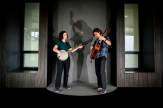This Northeastern poet is using computation to write poems—and winning awards for it

The current AI mania gripping much of the advanced world has the techno-naysayers out in full force. End-of-the-world prognostications abound; but they may be overshadowing some of the more positive examples of collaborations between human beings and computers.
Enter Lillian-Yvonne Bertram, a poet who—in addition to making poems—is making waves by putting to use computer programs designed to manipulate text to aid in the writing of those poems.
A champion of applying the latest technology to one of humanity’s most enduring creative activities, Bertram says they are “neither techno-dystopic nor techno-utopic.” Rather, Bertram is just one of many artists who is “embracing the computational,” using the latest software tools to investigate how algorithmic processes can be harnessed to co-create works of art every bit as real and compelling as art made the old-fashioned way.
“When people first started programming computers, one of the first things they were trying to do was to get them to write poems,” Bertram, an associate professor of English, Africana Studies and Art and Design at Northeastern, tells Northeastern Global News. “So there’s this long history, especially with poems and computers, that’s actually out there and really fascinating.”
Bertram’s last book, “Travesty Generator,” is almost entirely devised of algorithmically guided—that is to say, “computational”—poems. According to its dust jacket, Bertram “re-engineers language by synthesizing the lyric and coding script,” examining the Black experience and structures of white supremacy. At its heart, the book examines how ubiquitous and purportedly neutral computer code helps scaffold racial bias to the systems that sustain it, Bertram says.
“Code, written by white men, is part of the hardwired system of white supremacy, where structural violence begets itself,” the writer Cathy Park Hong writes of Travesty Generator. The book was longlisted for the 2020 National Book Award for Poetry.
While the book’s themes may become evident upon first read, the way it was produced—in consultation with programming languages such as Python—touches on questions of authorial intent, agency and creativity at a moment when large language models, such as ChatGPT, are beginning to reshape the nature of work and workplace productivity.
“There’s a bit of a myth around, Well, it’s removing the author, or it’s removing intention,” Bertram says of the computational approach. “And to some degree, yes, because you can’t predict the exact outcome. But the outcome is going to be within certain constructed parameters. And I know it’s going to be within a certain structure, because I made the structure.”
Bertram would create the computer programs, which effectively generated words and lines of poetry using source or seed text. Included in the programs’ code are specific parameters for sentence structure that Bertram sets in order to get an output more in line with their aesthetic vision.
“Part of how I would describe them [the poems] is linked to how they’re made,” Bertram says. “Some of the poems in Travesty Generator are combinatorial, and one of the hallmarks or features of that kind of poetry is repetition. So they’re very repetitive; they’re very iterative. Because that’s what programs do, they iterate on a loop.”
By effectively automating the associative logic poets use when writing poems, Bertram says they draw from the aesthetic traditions of Dada, a movement in the visual arts at the onset of the 20th century that sought new technologies of expression beyond the merely rational; and Oulipo, a generative approach to literature that utilizes constraint as a means of prompting a writer.
The programs Bertram creates, they say, mirror their own writing process.
“They sort of leap from one thing to the next, but that’s also sort of like the kind of writing that I do anyway,” Bertram says. “There’s not a whole lot of narrative coherence or throughline in that sense; because that’s not necessarily what I’m invested in as a writer.”
The whole project, Bertram says, has given them a new outlook on what it means to create—to be creative.
“Because I was doing so much of the coding work myself, it became, in some ways, a creative act itself,” Bertram continued. “You’re not just using an AI machine that someone else has made, so in some ways it’s akin to making your own tool, or your own paint brush, or making your own pigment; which actually I’ve found to be a very human process.”
Tanner Stening is a Northeastern Global News reporter. Email him at t.stening@northeastern.edu. Follow him on Twitter @tstening90.





